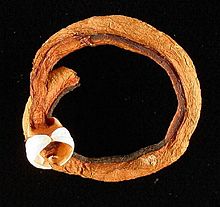Shipworm: Difference between revisions
link to porguese article |
GrahamBould (talk | contribs) mNo edit summary |
||
| Line 42: | Line 42: | ||
==References== |
==References== |
||
* {{ITIS|ID=81832|taxon=Teredinidae}} |
* {{ITIS|ID=81832|taxon=Teredinidae}} |
||
* [[Arthur William Baden Powell|Powell A W B]], ''New Zealand Mollusca'', [[HarperCollins|William Collins Publishers Ltd]], Auckland, New Zealand [[1979]] ISBN 0-00-216906-1 |
* [[Arthur William Baden Powell|Powell A. W. B.]], ''New Zealand Mollusca'', [[HarperCollins|William Collins Publishers Ltd]], Auckland, New Zealand [[1979]] ISBN 0-00-216906-1 |
||
[[Category: |
[[Category:Teredinidae| ]] |
||
Revision as of 15:27, 5 December 2007
| Shipworm | |
|---|---|

| |
| Teredo sp. | |
| Scientific classification | |
| Kingdom: | |
| Phylum: | |
| Class: | Bivalvia (or Pelecypoda)
|
| Order: | |
| Family: | Teredinidae Rafinesque, 1815
|
| Genera | |
|
See text. | |
Shipworms are notorious for boring into, and eventually destroying, wooden structures which are immersed in sea water, including piers, docks and wooden ships. Sometimes called "termites of the sea", shipworms are not in fact worms, but rather a group of very unusual saltwater clams with very reduced shells. They are marine bivalve molluscs (Eulamellibranchiata) in the family Teredinidae.
They bore into submerged wood, and bacteria in a special organ called the gland of Deshayes enable them to digest cellulose. The excavated burrow is usually lined with a calcareous tube.
The shipworms belong to several genera, of which Teredo is the most commonly mentioned. The best known species is Teredo navalis. Historically, Teredo concentrations in the Caribbean Sea have been substantially higher than in most other salt water bodies.
Shipworms have slender worm-like forms, but nonetheless possess the characteristic structures of bivalves. The valves of the shell of shipworms are small separate parts located at the anterior end of the worm, used for excavating the burrow. Shipworms greatly damage wooden hulls and marine piling, and have been the subject of much study to find methods to avoid their attacks.
In the early 1800s, the behaviour and anatomy of the shipworm inspired the great British engineer Marc Brunel. Based on his observations of how the shipworm's valves simultaneously enable it to tunnel through wood and protect it from being crushed by the swelling timber, Brunel designed an ingenious modular iron tunnelling framework - a tunnelling shield - which enabled workers to successfully tunnel through the highly unstable river bed beneath the Thames. The Thames Tunnel was the first successful large tunnel ever built under a navigable river.
Genera
- Bactronophorus
- Bankia Gray, 1842
- Dicyathifer
- Kuphus
- Lyrodus Binney, 1870
- Nausitoria Wright, 1884
- Neoteredo
- Nototeredo Bartsch, 1923
- Psiloteredo
- Spathoteredo Moll, 1928
- Teredo Linnaeus, 1758
- Teredora Bartsch, 1921
- Teredothyra Bartsch, 1921
- Uperotus
References
- "Teredinidae". Integrated Taxonomic Information System.
- Powell A. W. B., New Zealand Mollusca, William Collins Publishers Ltd, Auckland, New Zealand 1979 ISBN 0-00-216906-1

